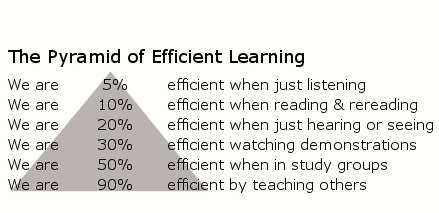What Does Study Mean in College
By Dennis Congos, University of Central Florida
In college, the word "study" includes many activities essential to
understanding, learning, and good performance on exams. Unfortunately, many
students do not know what to do beyond re-reading and cramming when studying
for college level classes.
It is valuable to students to understand that there are many tasks that must
be accomplished to do the job of learning properly in college. Some must be
done on a regular basis while others are done once or twice per semester. Below
is a listing of activities that are included under the term "study."
- Set up a study schedule that includes a minimum of 2 hours of studying
for every hour that you are in the classroom. This will vary some depending
on classes and majors. This is what the job of learning takes in college.
- Rewrite lecture notes as soon after class as possible.
- Read textbook assignments and build notes beginning from the day
of 1st lecture or textbook assignment.
- Quiz yourself over and over from your notes on a regular basis as
soon as you have notes. Using notecards really helps here.
- Self-test on a regular basis. Discover what you know and what you
don't know before you take a test when you can still do something about it.
Do not wait until you get a test back to find out what you have and have not
learned. Discover how may times you have to self-test in order to recall all
of the details from memory by looking only at a main idea.
- Form study groups. Compare notes, form potential test questions
and answers, quiz each other.
- Do homework.
- Work on assigned projects (individual and group).
- Attend SI sessions and get tutoring.
- Research for and write papers and essays. Start early and do little
by little each week.
- Include memory enhancers in your notes such as mnemonics, diagrams,
charts, sketches, drawings and other devices in notes to increase learning
and speed recall.
- Meet with a campus learning skills specialist about your study skills.
- Lab practice for language and science courses.
- See instructors during office hours.
- Teach or tutor someone else.
Learning Efficiency
Visualize a pyramid with 6 levels that represent levels of efficiency in learning.
The levels go from the top down in terms of learning efficiency.
Level 1 at the top shows 5% efficiency in learning when simply listening.
Level 2 shows we are 10% efficient when simply reading and rereading.
Level 3 indicated that humans are 20% efficient in learning when simply hearing
or seeing.
Level 4 shows a 30% efficiency when watching demonstrations.
On level 5, we are 50% efficient in learning when participating in study groups.
Level 6 clearly shows that we are 90% efficient in learning when we teach others.
The wise learner will include all 6 levels in learning whenever possible.

Questions or comments? Contact the author at dcongos@mail.ucf.edu.

